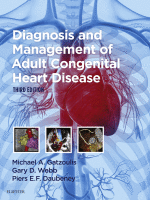Physical Address
304 North Cardinal St.
Dorchester Center, MA 02124

A 30-year-old woman with tetralogy of Fallot (TOF) repaired at age 5 years was seen in the adult congenital heart disease (ACHD) clinic. Her physician gave encouraging advice: there was no arrhythmia, the pulmonary regurgitation was only moderate, and right…

Congenital heart disease is one of the most common birth defects, and with 85% of these children now surviving into adulthood, an increasing number of patients require ongoing care. Many, but not all, will have had some corrective or palliative…

Acknowledgments We wish to thank Professor Adrienne H. Kovacs for the thorough and careful review of the manuscript. A 52-year-old man with severe Ebstein anomaly, atrial septal defect, and chronic cyanosis was followed for almost three decades as an out-…

Introduction Advances in pediatric and interventional cardiology, intensive care medicine, and cardiac surgery have resulted in tremendous improvements in life expectancy of patients born with a heart defect. Due to the decreased mortality in patients with congenital heart disease (CHD),…

The term pulmonary hypertension (PH) is broad and applicable to a group of conditions. The early 1990s saw major changes in the understanding of the spectrum of disease affecting the pulmonary circulation. We have also seen the central place of…

Pregnancy in any woman is a physiological challenge, but in women with congenital heart disease (CHD) it may pose considerable risks to both mother and fetus. Cardiac disease remains the most common cause of indirect maternal death in the United…

Heart malformation is the most common form of congenital abnormality, occurring in approximately 0.8% of all babies born. Following improvements in surgery and medicine since the 1960s, most people with congenital heart disease now survive to adulthood, and about half…

For the first time in history, there are now more adults than children living with congenital heart disease (CHD) in North America. Adults with CHD of moderate or great complexity, however, remain at significant risk of heart failure, arrhythmias, additional…

In 1885, Sir William Osler summarized beautifully the main aspects of clinical infective endocarditis (IE) in the Gulstonian Lectures delivered at the Royal College of Physicians of London. Despite all medical advances in the last 130 years, IE is still…

Implantable Cardiac Devices and Congenital Heart Disease Survival of children with congenital heart disease (CHD) continues to improve in lockstep with advances in surgical and medical therapy, and more than 90% now reach adulthood. Despite the impressive anatomic repairs that…